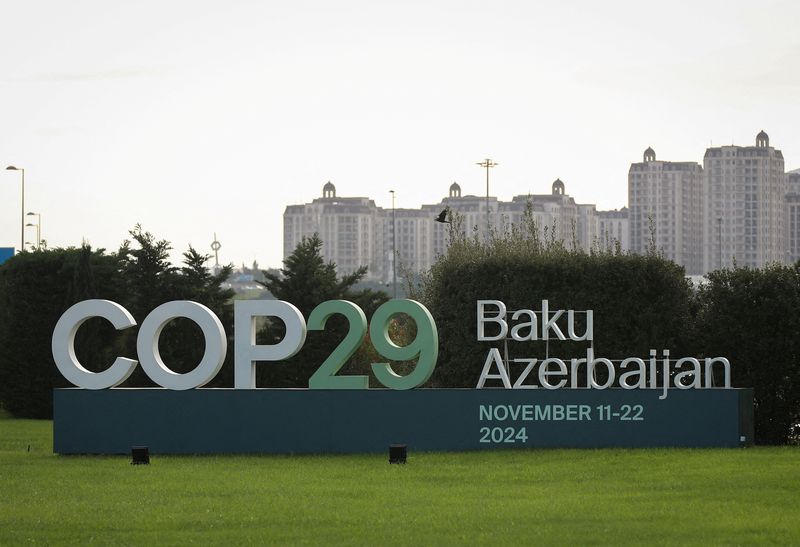Explainer-COP29: What are the key issues at the UN climate summit in Baku?
2024.11.07 01:06
By Valerie Volcovici
(Reuters) – This month’s U.N. climate summit – COP29 in Baku, Azerbaijan – has been dubbed the “climate finance COP” for its central goal: to agree on how much money should go each year to helping developing countries cope with climate-related costs.
That discussion could be tough following Tuesday’s re-election of former U.S. President Donald Trump, a climate denier whose campaign vowed to remove the top historic greenhouse gas emitter and leading oil and gas producer from the landmark 2015 Paris Agreement to fight climate change for a second time.
COP29 delegates will also be looking to advance other deals made at previous summits.
Here are some of the top agenda items for the Nov. 11-22 summit.
CLIMATE FINANCE
The acronym dominating this year’s summit is NCQG – which stands for the New Collective Quantified Goal.
That refers to the new annual climate financing target, which is meant to kick in when the current $100 billion pledge expires at the end of this year.
Wealthy nations have only sometimes met that annual goal since 2020, leading to growing mistrust among the world’s climate-vulnerable nations.
As COP29 aims to set a much higher target for the years ahead, wealthy nations insist the money cannot come entirely from their budgets.
Instead, they are discussing a far more complex effort that would involve reforming the global multilateral lending complex in ways that de-escalate climate-linked financial risks and encourage more private capital.
It is unclear how much of the total annual target would be offered by rich nations. Also unresolved is whether fast-developing nations like China or the Middle East Gulf oil states should also contribute, a position championed by the United States and European Union.
By reforming the global banking system, countries hope to drive up the annual climate finance sum. U.N. agencies estimate that trillions of dollars are needed yearly, but officials with the COP29 host Azerbaijan said that a number in the “hundreds of billions” has a more realistic chance of being approved by consensus.
FOSSIL FUEL TRANSITION
Last year’s COP28 summit in Dubai ended with countries agreeing for the first time to “transition away from fossil fuels in energy systems.”
Since then, however, both fossil fuel use and export sales have continued to rise globally, while new areas have been approved for oil and gas production in countries like Azerbaijan, the United States, Namibia, and Guyana.
With countries and companies unclear in their resolve to quit coal, oil and gas, negotiators said COP29 was unlikely to deliver timelines or stronger language on fossil fuels, though some countries might push for a halt in new coal plant permitting.
Countries will also be discussing progress in their pledge to triple renewable energy capacity and double energy efficiency, as a way of easing demand for fossil fuels.
RULES FOR CARBON MARKET
Governments are eager to resolve rules for trading carbon credits earned through the preservation of forests and other natural carbon sinks.
While these credits are meant to be issued to nations as optional offsets to their countries’ emissions, they can also be traded on open markets. Business leaders are looking for COP29 to set rules for guaranteeing transparency and environmental integrity in projects logged with the Paris Agreement Crediting Mechanism (PACM).
Still to decide are key issues including how the PACM supervisory body will set standards, if credits should be evaluated before being traded, and whether and when credits can be revoked.
BOOSTING TRANSPARENCY
Azerbaijan hopes countries will submit their first climate action progress reports during the summit ahead of a Dec. 31 deadline, but it is unclear if countries will do so.
These so-called Biennial Transparency Reports (BTRs) are meant to describe a country’s progress in reaching its climate goals – and how much further they need to go in setting fresh goals by February. As it stands, national pledges to cut emissions still fall far short of what is needed, the U.N. said last week.
The BTRs will also offer insight into how much finance is currently needed in developing countries, both for transitioning their economies away from fossil fuels and for adapting to the conditions of a warmer world.
ADAPTATION IN FOCUS
Countries last year committed to a framework of guidelines for national plans to help people adapt to climate disruptions such as warmer days, rising sea levels or parched farmlands.
But the framework for adaptation lacks details, such as quantifiable targets for measuring progress or strategies for linking projects with climate finance.
Countries hope to set more specific adaptation goals during COP29.
MONEY FOR LOSS AND DAMAGE

Two years since Egypt’s COP27 summit agreed to help poor countries with the costs of climate-driven disasters like extreme floods, storms or drought, about $660 million has been mobilized through the newly created Fund For Responding To Loss and Damage, that will be headquartered in the Philippines.
Climate-vulnerable countries will call on wealthy nations to offer more for the fund.








